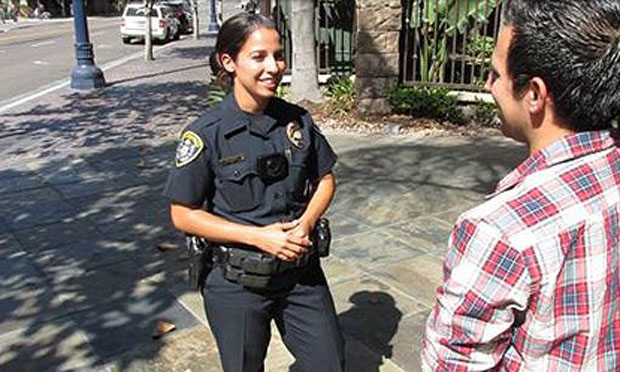The issue: Research suggests that various factors influence the opinions people form about police and the criminal justice system. Personal interactions have the strongest impact, according to the National Institute of Justice, the research arm of the U.S. Department of Justice. Media reports also affect the public’s view of policing agencies and how fairly laws are enforced. Some research has looked specifically at how race and class affect perceptions. For example, a 2014 report from the Pew Research Center suggests that African Americans are more likely than white or Hispanic people to perceive racial bias in dealings with police and the court system. A newer Pew report, released in September 2016, found that “only about a third of blacks but roughly three-quarters of whites say police in their communities do an excellent or good job in using the appropriate force on suspects, treating all racial and ethnic minorities equally and holding officers accountable when misconduct occurs.”
An academic study worth reading: “Cynical Streets: Neighborhood Social Processes and Perceptions of Criminal Injustice,” published in Criminology, August 2016.
Study summary: Mark T. Berg, an associate professor of sociology at the University of Iowa, and his colleagues at Florida State, Ball State and the University of Georgia build on previous studies that show perceived racial biases in the application of the law are concentrated among people in impoverished areas, and among African Americans in particular. They set out to determine whether and how these perceptions are connected to neighborhood cynicism and negative experiences with law enforcement officers.
The authors examined a sample of 689 young black adults across 39 “neighborhood clusters” in Georgia and Iowa. Neighborhoods varied in terms of their demographic characteristics, including racial composition and income. Using data mainly from the Family and Community Health Study (FACHS), they analyzed how perceptions of bias are affected by three factors: (1) negative police interactions, (2) “neighborhood structural disadvantage” — an umbrella term that takes into account such things as the proportion of residents who are unemployed or receive public assistance — and (3) moral and legal cynicism. Legal cynicism generally refers to a negative view of the law or the legal system as ineffective while moral cynicism generally implies a questioning of a person’s or agency’s moral credibility.
The authors controlled for 12 measures including gender, prior arrests and the neighborhood’s violent crime rate. Longitudinal time series data allowed the authors to assess effects over time.
Key findings:
- More impoverished neighborhoods tend to have higher levels of moral and legal cynicism.
- This collective cynicism explains much of the relationship between neighborhood structural disadvantage and perceptions of bias.
- Negative police encounters explain part of the relationship between legal cynicism and perceptions of injustice.
- There are several possible explanations for why neighborhood cynicism increases the occurrence of negative police-citizen encounters: cynicism might heighten sensitivities to stereotypes about African American suspects; or cynicism might signal to police officers that there are lower expectations about their conduct; or other explanations. Further work is required.
- Reactions to negative encounters vary by how cynical the neighborhood is. Cynicism may act as a “cultural filter against which police encounters are interpreted.”
- The results support public policy designed around high quality police-citizen interactions, particularly in more impoverished communities.
Helpful resources for journalists:
The Family and Community Health Study, conducted by Iowa State University and the University of Georgia, is the “largest in-depth study of African-American families in the United States, focusing on the way in which family and community processes and characteristics, as well as genetics, influence child and adult well-being.”
A Pulitzer Prize-winning database of police shootings, created by The Washington Post, shows that police in the U.S. shot and killed 991 people in 2015. Journalists can search the database to find deaths by race, gender, age and other characteristics.
The federal Bureau of Justice Statistics makes law enforcement data on excessive use of force available on its website.
The Center for Policing Equity is a think tank at the University of California, Los Angeles that focuses on community policing issues.
Other helpful research:
Journalist’s Resource has profiled several studies on policing in minority communities, including research on excessive or reasonable force, perceptions of police discrimination, how body cameras affect police interactions with the public, and deaths in police custody.
A U.S. Department of Justice report released in August 2016 finds that the Baltimore Police Department “makes stops, searches and arrests without the required justification; uses enforcement strategies that unlawfully subject African Americans to disproportionate rates of stops, searches and arrests; uses excessive force; and retaliates against individuals for their constitutionally-protected expression.”
A July 2016 paper from the National Bureau of Economic Research, “An Empirical Analysis of Racial Differences in Police Use of Force,” suggests that black people are more likely than white people to be beaten by police, but less likely to be shot. The study looks at racial bias after police initiated an encounter with a civilian.
A 2011 study published in the American Journal of Sociology, “Cultural Mechanisms and the Persistence of Neighborhood Violence,” examines the consequences of legal cynicism, including its effect on neighborhood violence.
Keywords: race, community relations, neighborhood policing, racial disparity


Expert Commentary